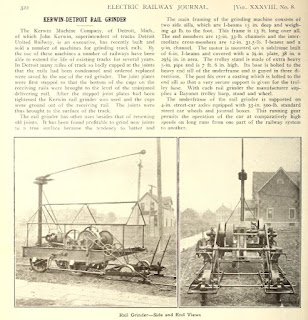I don't have much info on SDTE 100, and in fact it has heretofore been listed as being a 1900 product of Brill. But, of course, I couldn't find anything about it in the Brill order books, and now I know why. I've updated its builder to the Kerwin Machine Company and removed the year built; I'd guess it's likely around 1910 but can't be sure. The rail grinder in Mexico City has been modified somewhat - it's lost the "skate" hanging off the rear and has had a small platform built onto the front with a dash panel and possibly a controller - but it's got to be a Kerwin. (Given that Kerwin was based in Detroit; that city was using these grinders as of 1911; and Mexico City bought a bunch of Detroit PCCs in the 1950s, it's tempting to wonder whether this critter ran in Detroit and came to Mexico City secondhand. But there's no evidence for that, and rail grinders of this description don't appear at all in my CERA book on Detroit Street Railway.)
SDTE 100 is unassuming but is pretty unusual, actually. First, it's one of only two cars on the list with an "A1" wheel arrangement, designating four wheels and a single motor (the other is the homebuilt Ponemah Mills line car at the Connecticut Trolley Museum). It's also the only thing on the list built by Kerwin. More importantly, it's one of only 12 electric railway rail grinders preserved, and one of only five built for that purpose (the other seven were rebuilt from older streetcars). Of those five, two (one each at the National Museum of Transport and Southern California Railway Museum) sport more typical "house" construction. That leaves only this and two similarly diminutive (and skeletal) grinders built by the Goldschmidt Thermit Company, both preserved at Seashore.

No comments:
Post a Comment